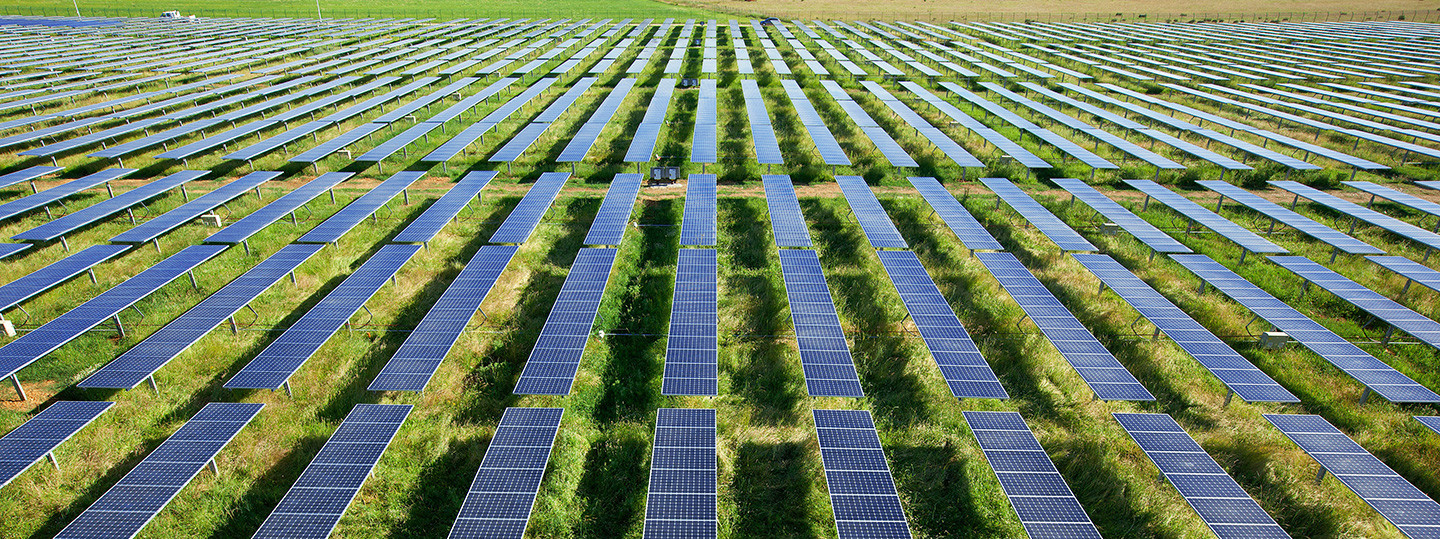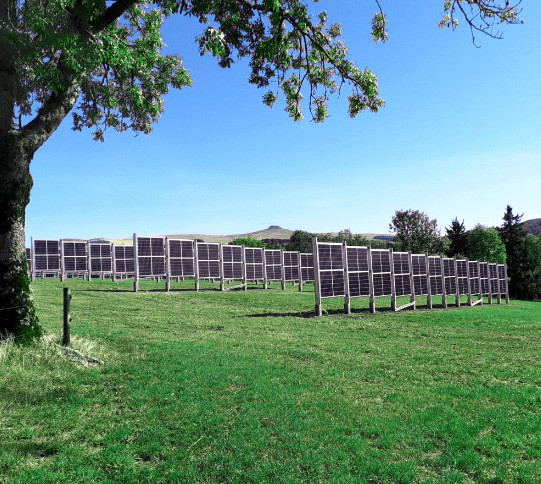
Agri-PV - an innovative technology with double benefits
Agri-Photovoltaics (Agri-PV) is an exciting topic for energy producers and farmers. No wonder, the simultaneous use of land for photovoltaic systems and agricultural purposes solves a classic conflict of goals. Thus, Agri-PV contributes to the energy transition in an innovative way. In this article, we explain why and provide more facts worth reading.
Photovoltaics and agriculture: a trade-off with a space problem
Food and energy represent vital foundations of our society. Yet the cultivation of food and the generation of electricity have one thing in common: they require a lot of space. Thus, the expansion of photovoltaics requires new open spaces. These can be roofs. However, meadows and fields in particular serve as locations for larger plant complexes. Here, however, conventional systems come into a conflict of use. They occupy land that was previously intended for agricultural purposes. Farmers and other landowners have therefore had to make a choice up to now: Electricity or food - both are not possible.
Agri-PV as an innovative solution
The principle of Agri-PV is as simple as it is ingenious. Specially designed photovoltaic systems allow the dual use of an area for electricity generation as well as food production. The concept is not new. In the article "Potatoes under the collector" in the magazine "Sonnenenergie", physicists Prof. Dr. Adolf Goetzberger and Dr. Armin Zastrow discussed the idea as early as 1981. Today, the principle is being used on German fields. The process makes it possible to expand photovoltaics while at the same time preserving agricultural land. This is a real win-win situation for the energy transition and agriculture - along with numerous other benefits for farmers, landowners and plant operators.
The common types of Agri-PV systems
In Germany, two common types of systems in particular are used for Agri-PV: elevated and ground-mounted systems.

High-Elevation Plants
High-mounted Agri-PV systems are usually jacked up four to six meters high via a linkage. The bottom edges of the modules are at least 2.1 meters above the ground. For agricultural use, elevated mounting has significant advantages: even large plants can grow under the module rows or farm animals such as cows can move around. Depending on the plant height and width, it is also possible to drive agricultural machinery such as tractors along under the modules.
Advantages of high-rise systems:
- very low loss of area of no more than 10 percent
- suitable for many types of cultivation - for example, permanent crops, permanent grassland, and cut and pasture use
- demonstrably positive effects on the microclimate below the plants
- Weather protection for plants and animals and replacement of protective devices such as netting
- Attachment of irrigation systems or climbing aids possible
- Good to know: The investment costs for high elevation systems are at least twice as high as for conventional photovoltaic systems. Specifically, the costs depend on the desired elevation height as well as the number of modules mounted. Of course, the higher costs must be offset by the profits from agricultural yields, depending on the application.
Low-ground systems
Ground-mounted Agri-PV systems are located much lower than elevated ones. The lower edges of the modules in this type of system are a maximum of 2.1 meters above the ground. So-called vertical-bifacial constructions are common. These are vertically elevated modules with solar cells on the front and back of the modules. Ground-mounted systems are usually installed in rows at a distance of 8 to 12 meters. In between, agricultural use of the ground areas takes place. However, plants with high growth height are unsuitable for this purpose, as they can shade the modules and thus reduce their efficiency.
Advantages of ground-level plants:
- Minimization of land loss to a maximum of 15 percent - with vertical-bifacial design even to only about 1 percent.
- wind protection for animals and plants close to the ground, also less water evaporation and soil erosion under vertical plants
- planting under the modules is possible - for example in the form of a flowering strip
- Practical division of agricultural land by rows of plants as well as enclosure of livestock possible
Good to know: As a rule, ground-level systems are more favorable than elevated variants.

Agri-PV in Germany
In this country, the use of the new process is progressing slowly. Smaller research projects and practical tests have already been implemented. However, it is not yet possible to make any general recommendations for agri-PV systems. Energy and agricultural experts are currently researching the process in order to create economical and environmentally compatible concepts. In any case, the potential is there. According to a projection by the Fraunhofer Institute for Solar Energy Systems ISE, high-mounted agri-PV systems alone could bring an output of around 1,700 GWp to German fields. However, due to the wide variance in arable farming and livestock production, and considering individual site conditions, there will be no standard product for this. The plant types and sizes will differ between the various regions of Germany. In the north, there are likely to be larger systems due to the amount of sunshine, while in the south of the country there will be mostly smaller systems, according to the Fraunhofer Institute.
The legal framework for Agri-PV in Germany
While the legal framework for Agri-PV exists in principle, it is far from mature. Anyone who wants to set up an Agri-PV system must basically record the planned form of cultivation in a utilization concept. Among other things, this must include information on land loss, light and water availability, minimization of soil erosion and, last but not least, economic viability. For the building permit, specifications of the Federal Immission Control Act (BImSchG) must be complied with in terms of species protection testing, microclimate and biodiversity. However, the approval procedures are often not adequate and are based on partly outdated criteria for conventional photovoltaic plants.
However, standards that provide orientation in this regard already exist. The Fraunhofer Institute for Solar Energy Systems ISE has created a new framework with DIN SPEC 91434 "Agri-Photovoltaic Systems - Requirements for the main agricultural use". The standard specifies requirements for agri-PV, for example, to prevent misuse. Currently, DIN SPEC 91434 is being revised and will include requirements for conservation of use. So far, there is no legal framework for this in connection with photovoltaics.
The amendments to the Renewable Energy Sources Act (EEG) also provide for extended framework conditions for expansion. Agri-PV, for example, is included in the expanded range of areas for ground-mounted systems, along with floating systems on lakes, marginal strips and moors. Three new subsidy portfolios were also included in the regular tenders: Arable Agri-PV, Crop Agri-PV, and Grassland Agri-PV. In addition, there is a technology premium for high-rise systems.
Good to know: Farms using Agri-PV will continue to receive agricultural subsidies, provided at least 85 percent of the farm's land is used for agricultural purposes.
ENGIE and Agri-PV
As an innovator in renewable energy, we see the concept of Agri-PV as a great opportunity for the energy transition in Germany. The process resolves land use conflicts and has great potential in this country. Although the approval procedures in Germany are strict, this also has its good sides: The high requirements reconcile photovoltaics, agriculture and environmental protection and promote acceptance of the technology among farmers and the population.
By the way: We at ENGIE have been involved with the topic of agri-photovoltaics for quite some time. The first agri-PV systems were installed in France as early as 2011. From 2015, large-scale systems followed on an area of 10 hectares and more. This makes our neighboring country the cradle of Agri-PV in Europe. Our research laboratory ENGIE Laborelec contributes to the further development of the technology there with innovative pilot projects. These include the Camelia demonstration plant in Laqueuille in Auvergne. The vertical-bifacial pilot plant is located on a meadow used for livestock farming and achieves an output of 100 kWp. Building on this extensive know-how, ENGIE is currently developing the first major Agri-PV projects in Germany.
Our Expert










